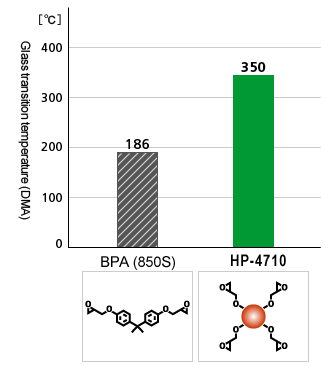Ultra-high Heat-resistant Epoxy Resin
EPICLON HP-4710
Functional Products
Electronics
Automotive
Packaging
Health Care
Color
Display
House Equipment / Infrastructure
Functional Materials
EPICLON HP-4710
Functional Products
Electronics
Automotive
Packaging
Health Care
Color
Display
House Equipment / Infrastructure
Functional Materials
EPICLON HP-4710 is a new epoxy resin developed for cutting-edge electrical component materials that demand excellent heat resistance and low thermal expansion.
Ultra-high heat resistance (world's highest level)
General-purpose solvent solubility
Low thermal expansion
Printed circuit board materials (semiconductor package substrates)
Core materials for build-up, insulated films
Automotive components
High density functional groups
High solubility for general-purpose solvents
| Product Number | HP-4710 | N-770 Phenolic Novolac |
|---|---|---|
| External Appearance | Brown solid | Light yellow solid |
| Epoxy Equivalent Weight (g/eq.) | 170 | 188 |
| Softening Point (°C) | 95 | 70 |
| Melt Viscosity (ICI) (150°C, dPa·s) | 9.0 | 5.5 |
| Solvent Solubility (MEK) | Dissolves | Dissolves |
Achieves an ultra-high glass transition temperature that reaches 350°C

| Curing agent | Imidazole (2E4MZ) 2 phr |
|---|---|
| Curing conditions | 200°C/5 hr |
Achieves the world's highest level of heat resistance in epoxy resins
Approximately 50°C increase in heat resistance compared to the phenolic novolac type

| Curing agent | Phenolic Novolac (TD-2131: softening point 80°C) |
|---|---|
| Accelerator | TPP (1 phr), Curing conditions: 175°C/5 hr |
Demonstrates a low coefficient of linear expansion
The coefficient of linear expansion (25 to 280°C) decreases about 20% compared to phenolic novolac
| Product Number | HP-4710 | N-770 Phenolic Novolac | |
|---|---|---|---|
| Glass Transition Temperature | °C DMA | 253 | 199 |
| °C TMA | 227 | 175 | |
| Coefficient of Linear Expansion | α1 40 to 60°C (ppm) | 54 | 55 |
| α2 (ppm) | 152(*1) | 166(*2) | |
| 25 to 280°C (ppm) | 83 | 105 | |
| Curing agent | Phenolic Novolac (Td-2131: softening point 80°C) |
|---|---|
| Accelerator | TPP (1 phr) |
| Curing conditions | 175°C/5 hr |
| Filler | None |
| Thickness | 2.4 mm |
Demonstrates extremely high heat resistance in laminate evaluations
The same moisture absorptivity as the phenolic novolac type while having a high functional group density
Excellent solder resistance
| Product Number | HP-4710 | N-770 Phenolic Novolac | |
|---|---|---|---|
| Glass Transition Temperature | °C DMA | 266 | 187 |
| °C TMA | 211 | 159 | |
| Moisture Absorptivity (PCT-4 hr) (%) | 1.08 | 1.13 | |
| Solder Heat Resistance (PCT-4 hr) | OOO | OOX | |
| Curing agent | Phenolic Novolac (TD-2090-60M) |
|---|---|
| Accelerator | 2E4MZ |
| Glass fabric | Nittobo 2116 type (100μm) 6-ply |
| Curing conditions | 200°C/1.5 hr |
Achieves excellent bonding properties while having high heat resistance
| Product Number | HP-4710 | N-770 Phenolic Novolac |
|---|---|---|
| Peel Strength (KN/m) | 1.3 | 1.0 |
| Delamination Strength (KN/m) | 0.7 | 0.6 |
Dissolves in general-purpose solvents such as MEK and cyclohexanone
| Solvent Type | Methyl Ethyl Ketone (MEK) | Cyclohexanone | Acetone | ||||||
|---|---|---|---|---|---|---|---|---|---|
| Nonvolatile Content (wt %) | 70 | 50 | 30 | 70 | 50 | 30 | 70 | 50 | 30 |
| Heating | X | X | X | X | X | X | X | X | X |
| Room Temperature | X | X | X | X | X | X | X | X | X |
| After 1 day | X | X | X | X | X | X | X | X | X |
| After 3 days | X | X | X | X | X | X | X | X | X |
| After 5 days | X | X | X | X | X | X | X | X | X |
| After 7 days | X | X | X | X | X | X | X | X | X |
| After 14 days | - | X | X | X | X | X | X | X | X |